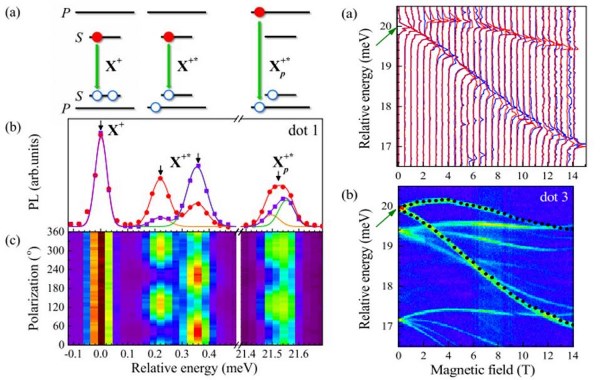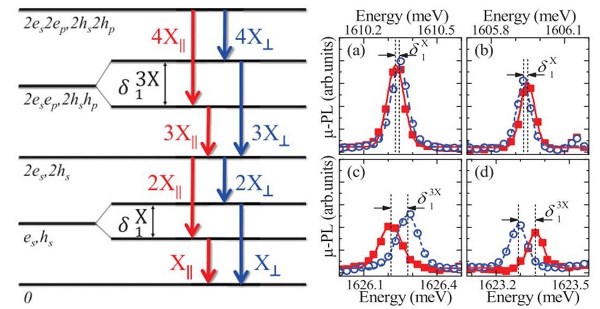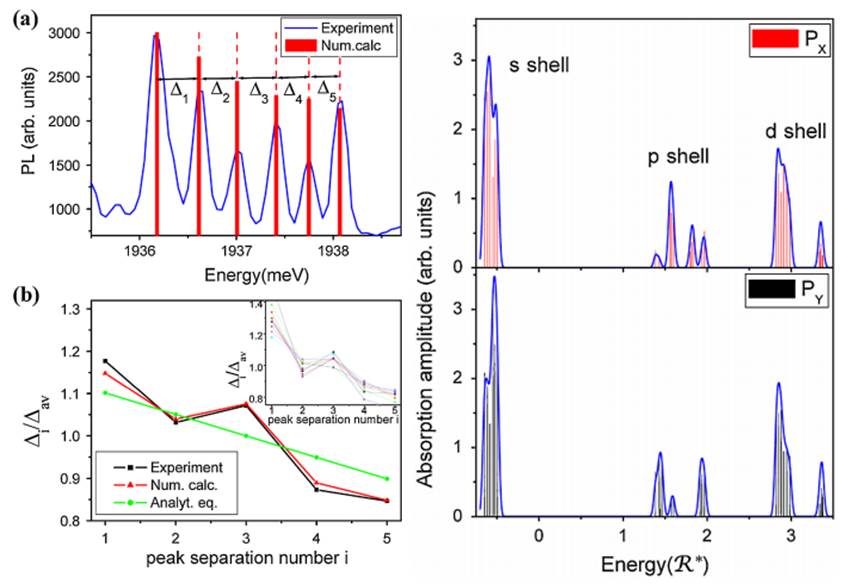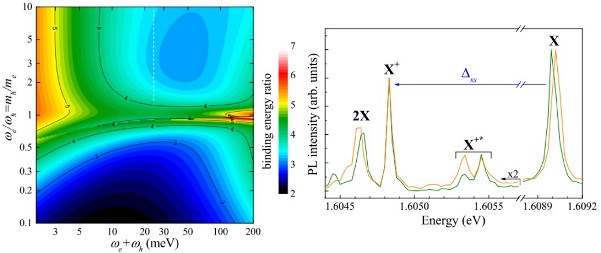- The excited spin-triplet state of a charged exciton in quantum dots
We report on single-object spectroscopic studies of a characteristic set of three resonances which appear in GaAlAs/AlAs quantum dot structures. The experiments included the photoluminescence (PL) and photoluminescence excitation (PLE) spectroscopy, photon-correlation measurements, analysis of the linear polarization of the emission spectra as well as the PL and PLE spectroscopy performed as a function of magnetic field. The investigated resonances are assigned to three different states of a positively charged exciton : a singlet ground state, a conventional triplet state (involving an electron from the ground state electronic s-shell), and additionally, a highly excited triplet state (involving the electron from the excited electronic p-shell). Advantageously (due to partially suppressed relaxation efficiency), the emission due to the highly excited triplet can seen in the spectra which allows us to scrupulously determine its properties and compare them to those of the conventional triplet state. Whereas both triplet states show similar patterns of the fine structure and Zeeman splitting, the splitting amplitudes are found to be significantly different for these two states. The presented results emphasize the role of the symmetry of the electronic state on the properties of the triplet states of the two holes + electron excitonic complex

More on this topic : M.R. Molas, J. Phys. : Condens. Matter 28, 365301, (2016)
- Quadexciton cascade and fine-structure splitting of the triexciton in a single quantum dot
We report on the properties of emission lines associated with the cascaded recombination of a quadexciton in single GaAlAs/AlAs quantum dots, studied by means of polarization-resolved photoluminescence and single-photon correlation experiments. It is found that photons which are emitted in a double-step 4X-3X process preserve their linear polarization, similarly to the case of conserved polarization of correlated photons in the 2X-X cascade. In contrast, an emission of either co-linear or cross-linear pairs of photons is observed for the 3X-2X cascade. Each emission line associated with the quadexciton cascade shows doublet structure in the polarization-resolved photoluminescence experiment. The maximum splitting is seen when the polarization axis is chosen along and perpendicular to the [110] crystallographic direction. This effect is ascribed to the fine-structure splitting of the exciton and triexciton states in the presence of an anisotropic confining potential of a dot. We also show that the splitting in the triexciton state surpasses that in the exciton state by a factor up to eight and their ratio scales with the energy distance between the 3X and X emission lines, thus, very likely, with a lateral size and/or a composition of the dot.

More on this topic : M.R. Molas, EuroPhys. Lett. 113, 170004, (2016)
- Quantum interference in exciton-Mn spin interactions in a CdTe semiconductor quantum dot
We show theoretically and experimentally the existence of a new quantum-interference effect between the electron-hole interactions and the scattering by a single Mn impurity. The theoretical model, including electron–valence-hole correlations, the short- and long-range exchange interaction of a Mn ion with the heavy hole and with electron and anisotropy of the quantum dot, is compared with photoluminescence spectroscopy of CdTe dots with single magnetic ions. We show how the design of the electronic levels of a quantum dot enables the design of an exciton, control of the quantum interference, and hence engineering of light-Mn interaction.

More on this topic : A. H. Trojnar et al., Phys. Rev. Lett. 107, 207403, (2011)
- Brightening of dark excitons in a single CdTe quantum dot containing a single Mn2+ ion
A promising method to investigate dark exciton transitions in quantum dots is presented. The optical recombination of the dark exciton is allowed when the exciton state is coupled with an individual magnetic impurity (manganese ion). It is shown that the efficient radiative recombination is possible when the exchange interaction with the magnetic ion is accompanied by a mixing of the heavy-light hole states related to an in-plane anisotropy of the quantum dot. It is also shown that the dark exciton recombination is an efficient channel of manganese spin orientation.

More on this topic : M. Goryca et al., Phys. Rev. B 82, 165323, (2010)
- Energy spectrum of confined positively charged excitons in single quantum dots
A theoretical model which relates the binding energy of a positively charged exciton in a quantum dot with the confinement energy is presented. It is shown that the binding energy, defined as the energy difference between the corresponding charged and neutral complexes confined on the same excitonic shell, strongly depends on the shell index. Moreover, we found that the ratio of the binding energy for positively charged excitons from the p and s shells of a dot depends mainly on the nearly perfect confinement inside the dot, which is due to the “hidden symmetry” of the multielectron-hole system. We applied the theory to the excitons confined to a single GaAlAs/AlAs quantum dot. The relevant binding energy was determined using microphotoluminescence and microphotoluminescence excitation magnetospectroscopy. We show that within our theory, the confinement energy determined using the ratio of the binding energy corresponds well to the actual connfinement energy of the investigated dot.

More on this topic : M.R. Molas et al., Phys. Rev. B 94, 235416, (2016)
